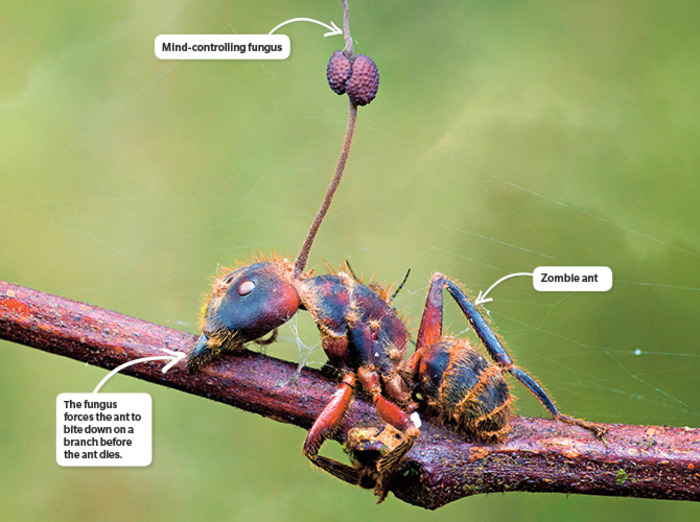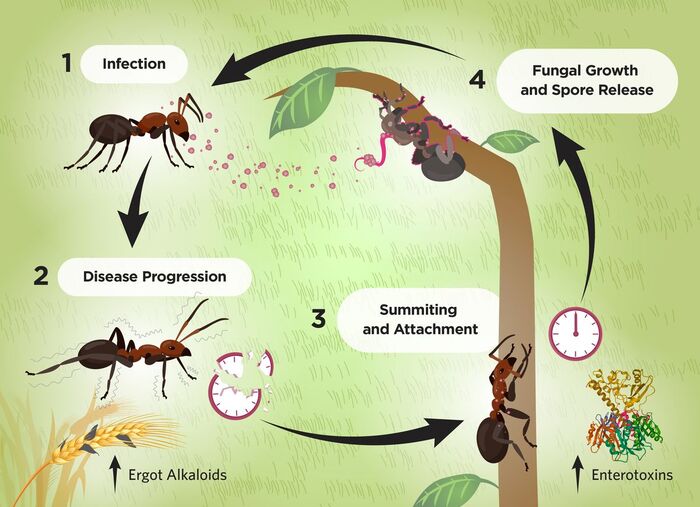If you've ever heard of a "zombie ant," then you're already familiar with the brain-eating fungus that affects fire ants and other insects. The story of how a tiny parasitic fungus can hijack the behavior of an ant is not only fascinating but also a prime example of the incredible, and sometimes terrifying, power of nature. In this article, we’ll dive deep into the world of Ophiocordyceps unilateralis, the infamous brain-eating fungus, and explore how it turns fire ants into its unwitting hosts.

brain eating fungus for a fire ant
The brain-eating fungus is scientifically known as Ophiocordyceps unilateralis, a parasitic fungus that specifically targets ants, particularly the fire ant. This fungus is known for its ability to infect ants and manipulate their behavior in a gruesome manner. When an ant becomes infected, the fungus gradually takes control of its body, effectively turning the ant into a "zombie" before it eventually kills it.
The infection begins when an ant encounters a fungal spore. The spore infiltrates the ant’s body and begins to grow, eventually controlling its central nervous system. The fungus uses this control to direct the ant to climb a plant or tree and attach itself to a leaf or stem using its mandibles. Once the ant is securely in place, the fungus kills it and continues to grow, producing spores that will fall to the ground below, ready to infect other ants that come into contact with them.
The process of infection by Ophiocordyceps unilateralis is nothing short of a horror movie plot. After the initial infection, the fungus takes control of the ant's behavior, forcing it to leave its colony and seek a high spot where it can latch on with its mandibles. This behavior is known as the “death grip,” where the infected ant bites onto a leaf or twig, never to let go until it dies.

How zombie fungus affects fire ants
The fungus then kills the ant, continuing its life cycle by releasing new spores, which fall to the forest floor and are picked up by other unsuspecting ants. This infection is especially devastating to ant colonies, as it allows the fungus to spread quickly and kill large numbers of ants, often without the colony ever realizing it until it's too late.
Understanding the life cycle of Cordyceps helps us appreciate just how well the fungus has evolved to thrive as a parasite. The cycle begins when an ant unknowingly becomes infected with the fungal spores. These spores attach to the ant's body and penetrate through its exoskeleton. From there, the fungus starts to consume the ant from within, taking over its central nervous system and forcing it to climb vegetation.
Once the ant is elevated and securely attached, the fungus kills it, and a stalk-like structure emerges from the back of the ant’s head. This stalk releases spores, which fall to the ground below, where they await another ant to encounter them. The fungus does not immediately destroy its host but instead uses the ant as a vehicle to transport itself to the ideal location for spore dispersal.
Ophiocordyceps is one of nature’s most remarkable parasitic fungi. What makes it especially interesting is the way it manipulates its host’s behavior. The fungus seems to have evolved a specific set of chemicals that interact with the ant’s brain, effectively taking control of its movements. This parasite-controlled behavior ensures the fungus can find the perfect spot to spread its spores and infect other ants.
Interestingly, Ophiocordyceps unilateralis appears to only affect certain types of ants, like fire ants. Its selective parasitism is an example of how the fungus has adapted to work within specific ecosystems, evolving to infect and control the ant species it is most suited for.
Once the fungus has successfully hijacked the ant’s body, it uses the ant's body to facilitate its own reproduction. The infected ant will remain latched onto a plant for up to a week, and once it dies, the fungal stalk grows out of its head, releasing spores to fall onto the forest floor below. These spores are then picked up by other ants, continuing the cycle of infection.
This parasitic control of an ant’s body and behavior is the stuff of nightmares, but it's also a stunning example of evolutionary adaptation. By using the ant as a "vehicle" for reproduction, the fungus ensures its spores are spread far and wide.
While brain-eating fungus in fire ants may seem horrifying, it's actually an important part of the ecosystem. The Cordyceps fungus helps control ant populations, preventing them from becoming too numerous and potentially disrupting the balance of local ecosystems. By targeting ants specifically, the fungus helps regulate the number of these insects, ensuring that they don’t overtake their environment.
Moreover, fungal parasitism in ants is part of the larger narrative of how nature maintains balance. This relationship between fungus and insect is a reminder that even parasitic organisms can play a crucial role in the survival of an ecosystem.
Ophiocordyceps isn’t just a fungus that targets fire ants. It affects a wide range of ants and other insects across the globe. While fire ants are one of the best-known hosts for this parasitic fungus, other species of ants, such as leaf cutter ants, also fall victim to this terrifying form of parasitism. The Cordyceps fungus has developed multiple species that target different types of ants, demonstrating its ability to evolve and adapt to a wide range of hosts.
While the brain-eating fungus is most famous for its impact on ants, particularly fire ants, researchers are also exploring its effects on other animals. Some species of Cordyceps fungi infect caterpillars, beetles, and even spiders, taking control of their hosts in similar ways. In fact, the concept of "zombie insects" isn't just limited to ants, as many parasitic fungi have evolved to manipulate the behavior of their hosts, creating "zombie-like" creatures to further their reproductive goals.
What exactly is the brain-eating fungus for fire ants?
The brain-eating fungus is Ophiocordyceps unilateralis, a parasitic fungus that infects ants, taking control of their brain and forcing them to climb vegetation where they attach, die, and release spores.
How does the fungus manipulate fire ants?
The fungus releases chemicals that hijack the ant’s brain, controlling its movement and forcing it to climb to high vegetation, where it attaches with its mandibles until it dies.
Are there other insects affected by brain-eating fungi?
Yes, other insects such as caterpillars, beetles, and spiders can also fall victim to various species of Cordyceps fungi, which manipulate their behavior in a similar way to fire ants.
The story of the brain-eating fungus for fire ants is a chilling yet fascinating tale of parasitism, survival, and nature’s complex systems. The Ophiocordyceps unilateralis fungus is one of nature’s most terrifying yet brilliant creatures, and its ability to control its hosts makes it a key figure in the ecological balance of many environments.
animal tags: Ophiocordyceps ants
We created this article in conjunction with AI technology, then made sure it was fact-checked and edited by a Animals Top editor.